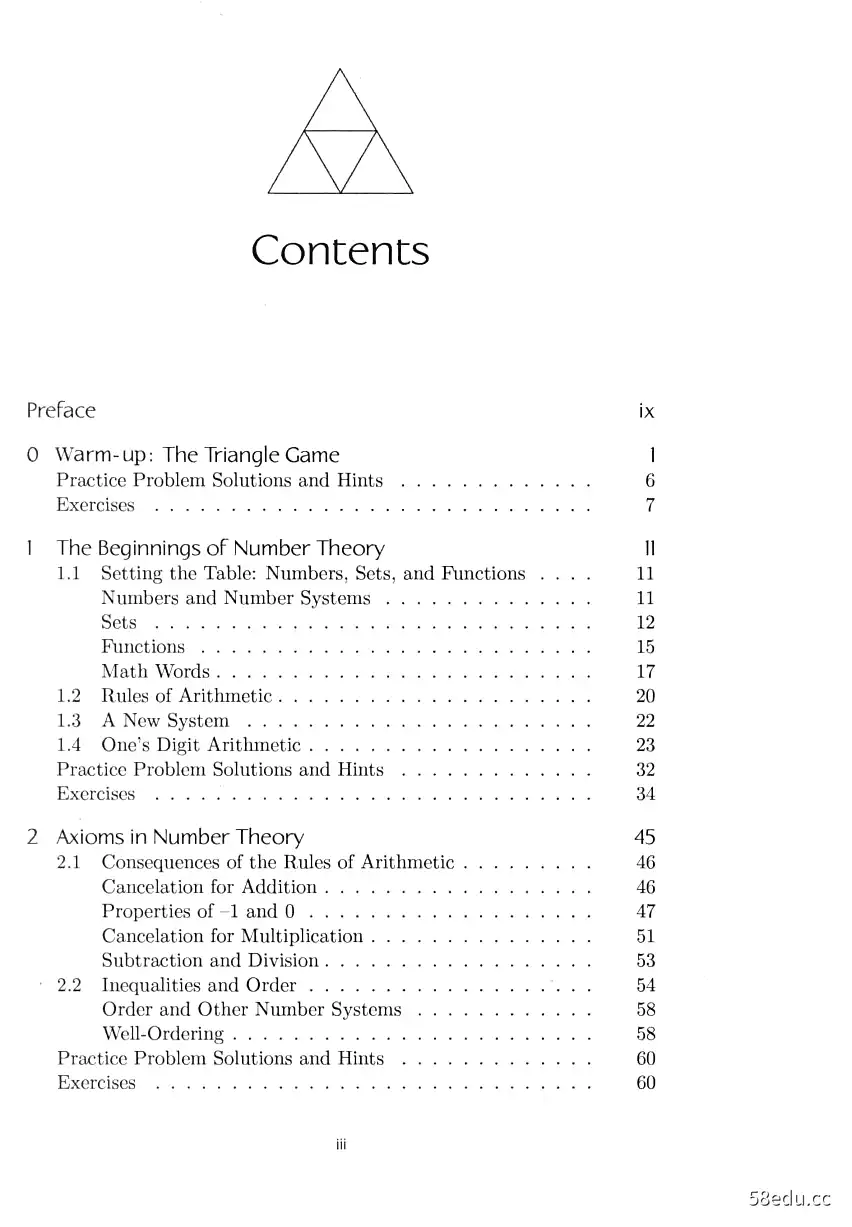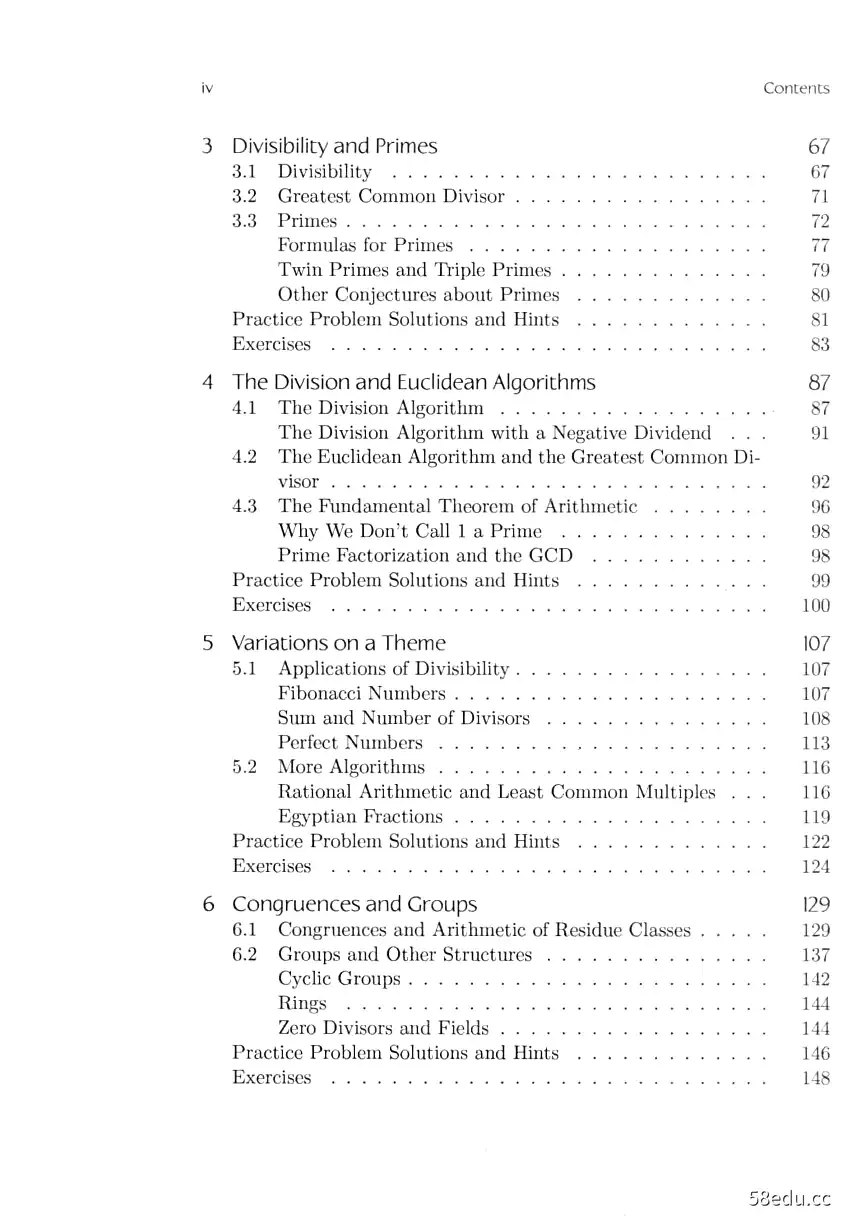《数、形与对称性 数论,几何和群论导论》(美)黛安.L.赫尔曼|(epub+azw3+mobi+pdf)电子书下载
图书名称:《数、形与对称性 数论,几何和群论导论》
- 【作 者】(美)黛安.L.赫尔曼
- 【页 数】 465
- 【出版社】 哈尔滨:哈尔滨工业大学出版社 , 2022.06
- 【ISBN号】978-7-5603-9971-3
- 【价 格】128.00
- 【参考文献】 (美)黛安.L.赫尔曼. 数、形与对称性 数论,几何和群论导论. 哈尔滨:哈尔滨工业大学出版社, 2022.06.
图书封面:
图书目录:


《数、形与对称性 数论,几何和群论导论》内容提要:
本书的前半部分着重于数论,以算术规则(整数的规则)作为开始。作者之后呈现了所有整除性、素数和模算术的基本思想和应用。同时介绍了群的抽象记号,并且包含了许多例子。数论的最后一个话题由有理数、实数及无穷的思想组成。在几何方面,本书涵盖了多边形和多面体,包括正多边形和正多面体的构造。它通过观察平面上的图案来研究镶嵌,特别是那些由正多边形及正多边形的集合组成的图形。本书同时研究了这些图形和图案的对称群,解释了这些群是如何在几何和数论中同时出现的。
《数、形与对称性 数论,几何和群论导论》内容试读
Warm-up:The Triangle Game
Let's start by investigating a problem we call the Triangle Game.The
Triangle Game shows that a mathematics problem may not have just asingle answer and that some solutions to a problem can lead to othersolutions as well as intriguing new questions in a direct and interestingway.The Triangle Game illustrates a fundamental mathematical idea:itshows that a problem can be presented to elementary school students inthe third or fourth grade and can be solved mainly by trial and error.
As the problem is approached in a more sophisticated way,we can usefundamental tools from algebra to reduce the trial-and-error approach tothe actual solution.
We begin by drawing an equilateral triangle.Now we draw a dot onthe midpoint of each side and at each vertex,or corner (see Figure A).
We place each of the numbers 1 through 6 on one of the dots,in any
Figure A
order.For example,let's start by putting 1 at the top and going aroundthe triangle clockwise,as in Figure B.
If we sum the numbers along each side,we get 1+2+3 6 on theright,3+4+5 12 across the bottom,and 5+6+1 12 on the left.
The object of the Triangle Game is to find all the ways to place the six
6
numbers on the dots in such a way that the sum along each of the threesides,or“side sum,”is the same.(Thus,Figure B is not a solution.)
5
Practice Problem 0.1.Before reading further,try to experiment and find
Figure B
some solutions to the Triangle Game.
When we explained how to start the game,we began by putting a 1at the top,but the side sums were different.Let's start with 1 at thetop.We want to experiment with computation to develop an algorithmfor finding solutions to the game.
If we start with the numbers 1,2,and 3 clockwise on the vertices,and carefully place 4,5,and 6 on the midpoints,we get a solution
2
OpThe Triangle Game
to the problem with a triangle whose side sum is 9 (see Fig-ure C).
5
Many students might stop playing the game now that they have founda solution to the problem.But as mathematicians,we are interested inthe other questions that this solution raises,such as:
1.Is this the only way to get 9 as the side sum?
Figure C
2.Can any other numbers be side sums?
3.Can 8 be a side sum?Or 13?
4.Can there be two different ways to place the numbers to get thesame side sum in the game?
By experimenting,we hope to find a complete solution to the Triangle
Game.
Practice Problem 0.2.Show that if you put a 1,5,and 3 from top tobottom along the left side of the triangle,there is only one way to solvethe Triangle Game,and that is the solution we already know.
We could try to develop an algorithm to solve the Triangle Game inseveral ways.Let's see what happens if we put 1 at a different vertex,say,the lower left.We could now proceed in either of two ways.One would
3
be to start with a 1 at the lower left corner and redo all the computationsto fill out the triangle.The other way would be to notice that if we rotateour original solution triangle(Figure C)120 counterclockwise,we get the1 at the lower left vertex and have a ready-made solution (see Figure E).
Notice that if we rotate Figure C 120 clockwise,the side sum isunchanged,but the numbers are in different places on the picture of the
2
6
triangle (see Figure D).
Figure D
We could also rotate Figure C another 120 clockwise,or 240 inall,and get Figure E,which we found before by rotating Figure C 120
2
counterclockwise.
There's another way to get a side sum of 9 using the original solution(Figure C)by flipping or reflecting it through a line that goes through anyvertex and the opposite midpoint.For example,if we draw such a linethrough the top of our original triangle (redrawn as Figure F,left),andflip or reflect around this line,we get another different-looking triangle
5
3
(Figure F,right),still with a side sum of 9.
Figure E
O The Triangle Game
3
5
6
5
2
4
Before Flip
After Flip
Figure F
There are two other flips of the original solution,one through theline from the bottom right vertex to the opposite side (Figure G),andone through the line from the bottom left vertex to the opposite side(Figure H).
3
6
Before Flip
After Flip
Figure G
5
44
6
6
Before Flip
After Flip
Figure H
So we now have six different-looking triangles,all with a side sum of
9.Even though the solutions look different,the same set of numbers ison the corners and on the midpoints.In all these triangles,the numbers
1.2,and 3 are on vertices and 4,5,and 6 are on the midpoints.
O The Triangle Game
Although we have now "solved"the problem with six different trian-gles,we can ask whether there are other possible solutions.This is wherewe need to bring some organizational unity to our search.We look forideas,or connections,that lead to other solutions.
Here's a way to begin this kind of thinking:to place the numberson the triangle,the number 6 must go somewhere,and the two smallestnumbers that can be paired with 6 are 1 and 2.So the smallest possibleside sum is 9.
Practice Problem 0.3.Using the same ideas,show that the largest possi-ble side sum is 12.
Through this deductive process,we can conclude that the only possibleside sums are 9,10,11,and 12.
Practice Problem 0.4.Using methods of experimentation and deduction,show that there is a solution for each of the side sums 9,10,11,and 12.
Also show that all other solutions with each side sum are related to yoursolution by rotation or reflection of the triangle
Actually,if we use some elementary algebraic techniques,we can re-fine this process to something less experimental.Start with the lettersa,b,c,d,e,f to represent the integers from 1 to 6 in some order.We placethe letters a,6,c at the vertices and fill in the midpoints with the lettersd,e,f (Figure I).
Assuming that we have a solution of the Triangle Game,we can write
Figure I
(a+d+b)+(b+e+c)+(c+f+a)=3S,
where S is the side sum.The sum of the integers from 1 to 6 is 21,sothis leads to the equation
a+b+c+21=3S
From this,we can conclude immediately that a+6+c is divisible by 3.
Starting with the smallest values,a =1,6=2,c=3,we get 6+21=3S
This tells us that to have a side sum 9,we must have 1,2,and 3 as thevertices.Taking the next step,the largest values of a,6,and c are 4,5,6.
This leads to the equation 15+21 =3S,or S=12.This is the largestpossible value of S.A solution with 4,5,and 6 on the vertices and 12 asa side sum is pictured in Figure J.
Figure
O The Triangle Game
5
Practice Problem 0.5.For the value S=10,we have a+b+c=9.Findthree distinct values of the integers from 1 to 6 that sum to 9.Is theremore than one case?Which of these cases can be used to create a sidesum of 10?
Is there a way to get one of these solutions from another one?Thinkabout how we might generate a solution with a different side sum fromthe triangle with side sum 9.One possibility is to use an idea calledduality,which exchanges the number x at a vertex with the number 7-x.
For example,in the triangle with side sum 9 we would interchange thenumbers 1 and 6,2 and 5,and 3 and 4.This results in a triangle withside sum 12 (see Figure K).
Before Exchange
After Exchange
Figure K
Practice Problem 0.6.Try to do this exchange with the triangles withside sum 10 and side sum 11 to see what happens.
We may finally conclude that in order to completely solve the Triangle
Game,we need to produce only one solution with side sum 9 and one withside sum 10,and then use reflections,rotations,and duality to get all theothers.These mathematical ideas thus streamline the way to arrive at acomplete solution.
Why do people enjoy problems such as the Triangle Game?There aremany reasons that different people find it appealing.One is that it hasone easy solution.Another is that it doesn't have just one solution.Thereare even some arrangements that we can argue are impossible.There issome interplay in this problem between the numbers on the figure andthe way the figure moves around with rotations and reflections.Thisgives a nice relation between the numerical and geometrical ideas thatcharacterize mathematics.In addition,in this problem we can get a smallnumber of basic solutions and use ideas such as symmetry and duality to
6
OThe Triangle Game
generate all the solutions to the problem.Finally,this problem leads togeneralizations and therefore new problems.For example,what wouldhappen if we played the Square Game,where we used the numbers 1through 8 on the vertices and midpoints of the edges of a square?Whystop there?What about a pentagon or hexagon game?Can we play asimilar game in three dimensions?All of these questions are interestingto ponder.
The Triangle Game illustrates what we are trying to do in this book
Even though this text does not emphasize computational algebra or provean overwhelming number of theorems,it does generate a significant num-ber of mathematical ideas.We will work carefully with these ideas togive a rigorous treatment of the underlying mathematical concepts.Wehope the reader will engage these mathematical ideas in a positive wayand learn about mathematical proof in number theory and geometry andthe relation between these two rich areas of mathematics.
Practice Problem Solutions and Hints
0.1.One strategy might be to try to place three numbers on a side thatadd up to 9.Then see if you can figure out where to put the other threenumbers to get a solution.
0.2.This starting position forces the number 6 to be on the midpoint ofthe side where 1 is a vertex.Then the places for 4 and 2 are determined.
0.3.The number 1 must go somewhere.The largest numbers that canbe paired with 1 are 5 and 6.So the largest possible side sum is 12.
0.4.Solutions with sums of 10,11,and 12 are shown below.
6
0.5.The possible solutions are 1+2+6=9,1+3+5 =9,and 2+3+4 =9.
Only the second of these yields a solution with side sum 10.Try it!
0.6.Look at the triangles in Practice Problem 0.4.
···试读结束···
作者:奚小燕
链接:https://www.58edu.cc/article/1717752360127774722.html
文章版权归作者所有,58edu信息发布平台,仅提供信息存储空间服务,接受投稿是出于传递更多信息、供广大网友交流学习之目的。如有侵权。联系站长删除。